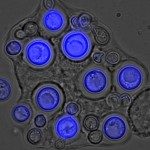Link to Pubmed [PMID] – 20435373
J. Hosp. Infect. 2010 Sep;76(1):52-5
Contamination of preservation solution (PS) with yeasts during solid organ recovery can lead to life-threatening complications in the recipients. The prevalence of such a contamination needs to be established. From January 2004 to December 2008, we prospectively investigated the potential fungal contamination of all the PSs collected in our institution using a standardised procedure consisting in centrifugation of 10 mL PS and incubation of the pellet seeded on fungal-specific medium for 15 days at 30 degrees C. During the study period, 728 transplantations (397 kidneys, 262 livers and 69 hearts) were performed for which 659 PSs (90.5%) were available. The yeast contamination rate was 0% (0/62), 3.1% (11/356) and 4.1% (10/241) for heart, kidney and liver transplants, respectively. We identified 10 Candida albicans, five C. glabrata, two C. krusei, one C. tropicalis, one C. valida, one Pichia etchelsii and one Rhodorula sp. Routine bacterial analysis identified only five of these 21 fungal contaminations. Twenty recipients were alive after at least one year of follow-up and one died from meningeal carcinomatosis at seven months. Three patients were found to have the same species of Candida from their surgical drains but did not develop any infection or abnormalities upon ultrasound investigation. Fourteen patients received antifungal drugs. Yeast contamination occurred in 3.4% of all kidney and liver PSs tested. Its clinical consequences and therapeutic management remain to be defined. Our study also suggests that optimisation/standardisation of microbiological procedures is warranted, including analysis of large PS volume, seeding of fungal-specific medium and prolonged incubation.

